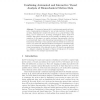Free Online Productivity Tools
i2Speak
i2Symbol
i2OCR
iTex2Img
iWeb2Print
iWeb2Shot
i2Type
iPdf2Split
iPdf2Merge
i2Bopomofo
i2Arabic
i2Style
i2Image
i2PDF
iLatex2Rtf
Sci2ools
ISVC
2010
Springer
2010
Springer
Combining Automated and Interactive Visual Analysis of Biomechanical Motion Data
Abstract. We present a framework for combining automated and interactive visual analysis techniques for use on high-resolution biomechanical data. Analyzing the complex 3D motion of, e.g., pigs chewing or bats flying, can be enhanced by providing investigators with a multi-view interface that allows interaction across multiple modalities and representations. In this paper, we employ nonlinear dimensionality reduction to automatically learn a low-dimensional representation of the data and hierarchical clustering to learn patterns inherent within the motion segments. Our multi-view framework allows investigators to simultaneously view a low-dimensional embedding, motion segment clustering, and 3D visual representation of the data side-by-side. We describe an application to a dataset containing thousands of frames of high-speed, 3D motion data collected over multiple experimental trials.
Applied Computing | Complex 3D Motion | ISVC 2010 | Motion Segment | Nonlinear Dimensionality Reduction |
Related Content
| Added | 28 Jan 2011 |
| Updated | 28 Jan 2011 |
| Type | Journal |
| Year | 2010 |
| Where | ISVC |
| Authors | Scott Spurlock, Remco Chang, Xiaoyu Wang, George Arceneaux, Daniel F. Keefe, Richard Souvenir |
Comments (0)

